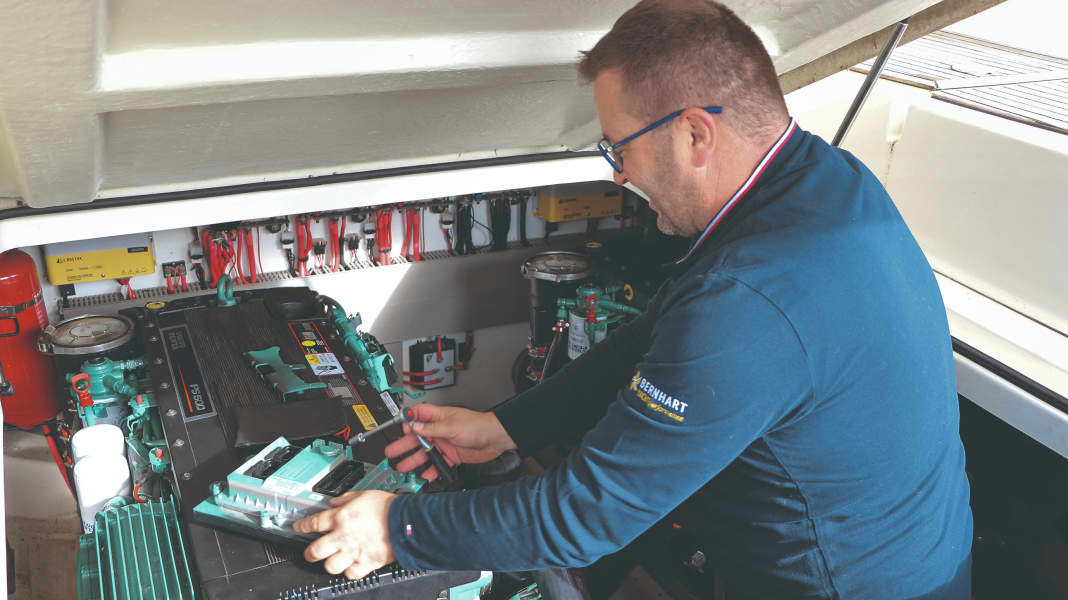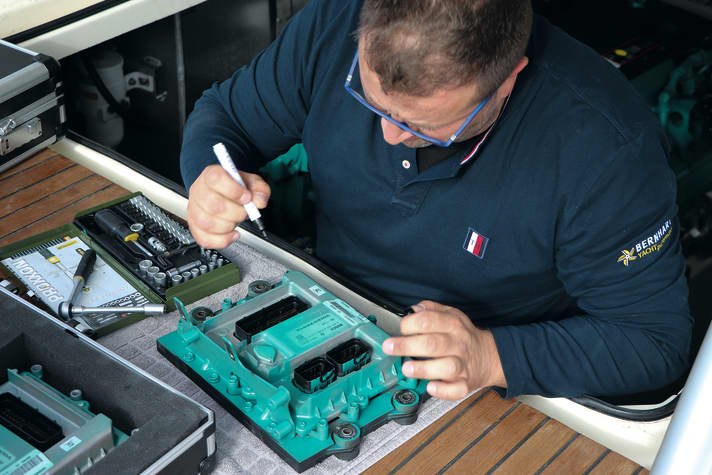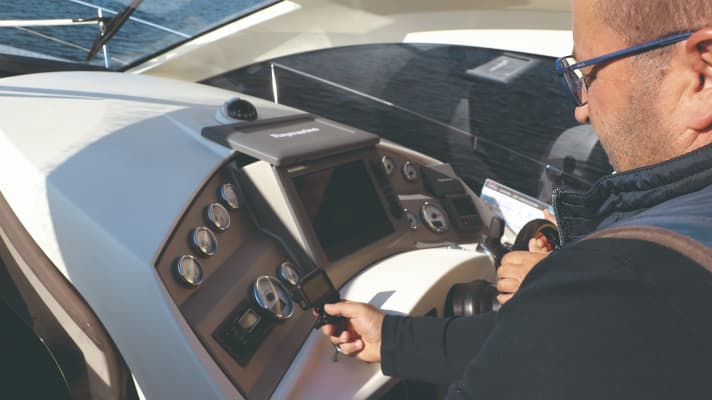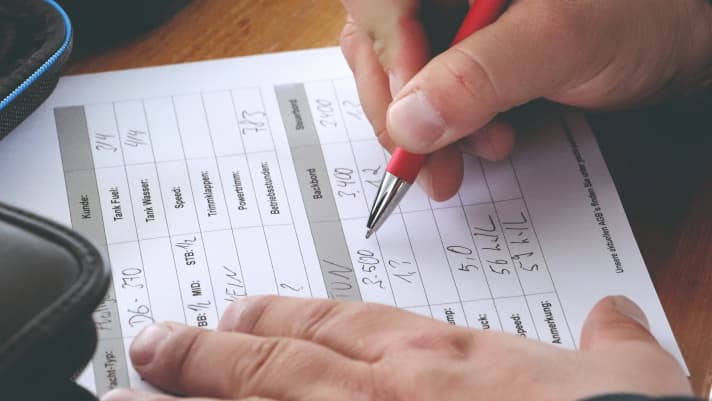
Today, the throttle levers are toggle switches: Frank Seifert pushes them all the way forwards with a jolt. Beneath our feet, the two Volvo Penta D6-370s of his Prestige 440S seem to come to life. The leisurely 5 knots down the Havel did not really challenge the two 6-cylinder diesels, but now they have to show what they are made of. Because standing next to Seifert is a man with a stopwatch, GPS and camera, meticulously tracking the hand of the rev counter as it sweeps clockwise up its scale. "3500 revolutions, 59 kilometres per hour," Stephan Bernhart announces the peak values exactly 19 seconds later, visibly satisfied. The tall man from Allgäu notes his measurement results with a pleasant grin. "You noticed the better acceleration too, didn't you?" he says to both the owner and the BOOTE editor, who are travelling with him on the Schwielowsee on this cold morning. "Yes, that was really impressive," confirms Seifert, as his Prestige roars along with a foaming wake. "The acceleration has changed noticeably," he confirms.

But what exactly has changed since the test drive the day before? The Prestige 440S still ran exactly as it did when it was delivered from the shipyard in 2011. Not bad, at least 55 km/h at 3300 rpm. But the acceleration was much slower. Until Stephan Bernhart took a look at the engine control units of the two Volvos last evening. Since the early morning, the ship now has a total of 120 hp more. It has been "tuned".
"You must never exaggerate when increasing performance"
"The word tuning has a somewhat negative connotation," admits Stephan Bernhart, "which is why I prefer to describe my service as 'map manufacturing'," he laughs. The task that he offers with his company Yacht-Performance is actually exactly the same as chip tuning a car: the subsequent increase in performance by specifically changing the control parameters set at the factory. Chip tuning has gained a bad reputation mainly due to the wide range of providers who, in return for money, will push any engine to or beyond its limits. Not everyone who offers such a service also has the knowledge and experience to change the programming of the engine control units specified by the manufacturer and to modify them as they see fit. This is why the bad reputation is often justified. After all, pushing the performance beyond the manufacturer's values ultimately leads to higher loads and often also higher wear. And it's not as if the manufacturers would sell their engines with poor programming for lack of better knowledge and the engines could actually do even more. So why such tuning?

"Many ships sail really well when they are delivered," explains Bernhart, "but owner-operated ships in the Mediterranean in particular become heaped with all kinds of ballast over the course of a ship's life and become increasingly heavy," he says. "One owner of a Galeon 510 contacted me because his boat with all sorts of retrofitted extras stopped gliding on his birthday with a few extra guests on board," Bernhart gives an example, "but I also know an owner who hasn't refuelled his boat for many years because it no longer runs well." From his point of view, in many cases it makes perfect sense to give the engines a little more power by exploiting the engine's thermodynamic and mechanical reserves a little more through map optimisation. Chip tuners like Bernhart can do this solely on the computer, without intervening mechanically in the engine. For example, by changing the injection timing.
"Acceleration has actually improved noticeably"
"You can't overdo it when increasing the power," he categorises, "and above all, you have to understand your craft." His cautious increase would also not affect the service life of the engine. The manufacturer's warranty of two or five years is lost with such an intervention, "but the engines are usually a bit older anyway, as in this case."
He himself - unsurprisingly - also comes from the automotive industry, but sees great potential in the water sports sector, because here too the wheat is increasingly being separated from the chaff of dubious offers. He was once commissioned by a man who had previously allowed another "optimiser" to work on the control units of his Bavaria 45. "After that, the engines wouldn't even start," reports Bernhart. "In order to get to know his competitors, he wrote to a few providers himself as a test and asked whether they could optimise his supposedly existing boat. "They wrote back telling me to send them the control unit," he says. "But you can't reprogramme an engine control unit if you haven't even driven the vehicle yourself and recorded the performance," he states.

So it's no wonder that tuning doesn't have a good reputation. In the case of the Galeon 510, Bernhart succeeded in compensating for the additional weight through performance and regaining the driving performance once achieved by the manufacturer. By increasing the power of the Volvo Penta D11-725 by 95 hp each, the ship reached a top speed of 65 km/h after the tuning (previously 55 km/h) and has twice the acceleration. "Enough for the owner to invite all his friends round again for his next birthday," says Bernhart with a twinkle in his eye.
In the case of our Prestige 440S, Bernhart is satisfied but not intoxicated. "The boat was already pretty well optimised from the outset," he admits, "and also very light as a weekend boat on the Havel, not overloaded like many boats in the Mediterranean." The improved acceleration is clearly noticeable after the optimisation, but "you would actually have to fit even larger propellers," he says, "this would make the engine turn a little slower and quieter, but increase the speed by 10 km/h. You can tell: a man who knows his job. He estimates two to three days for such an optimisation and charges a flat rate from 2900 euros per engine, plus travel expenses.
Let's ask the crucial question of additional consumption, which many a tuner knows how to gloss over. However, Bernhart doesn't beat about the bush: "Power comes from fuel, that's quite clear," he says, "and the additional consumption at full load will be around 5 to 10 per cent higher." In purely mathematical terms, the Prestige can now travel 7.2 per cent further in the same time. "However, for a ship of this size, whose engines each consume around 75 litres per hour, the additional consumption is hardly significant anyway."

